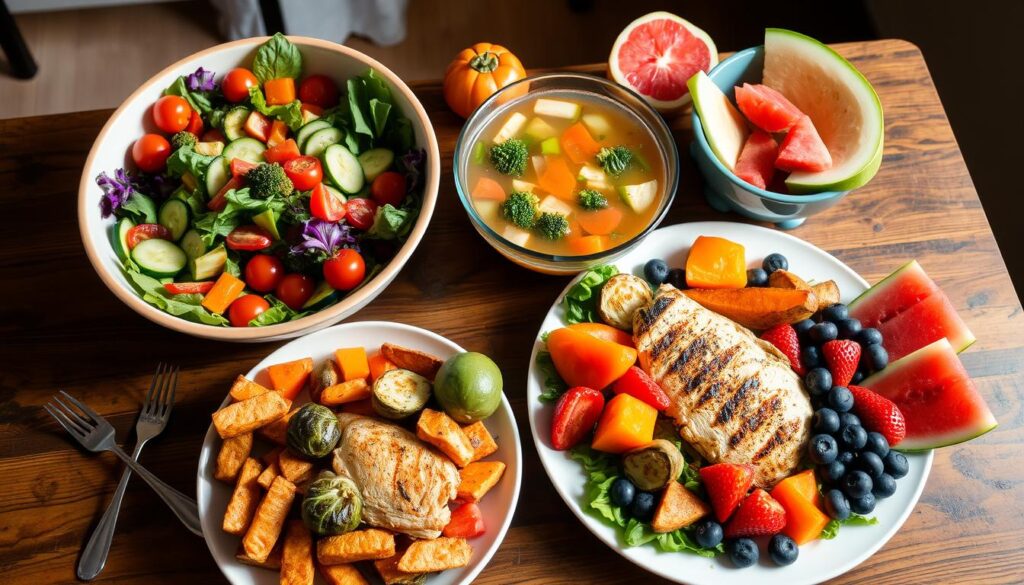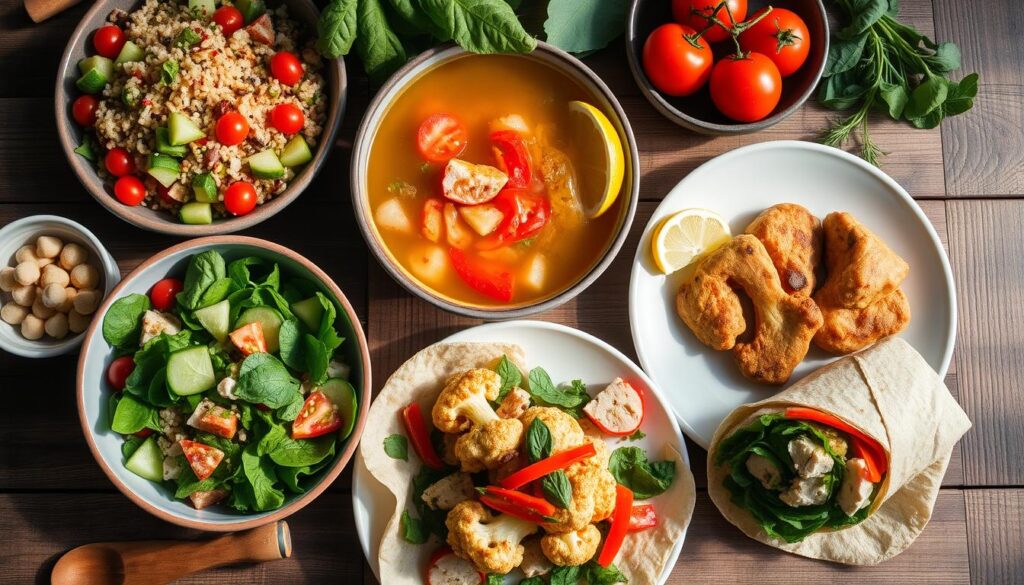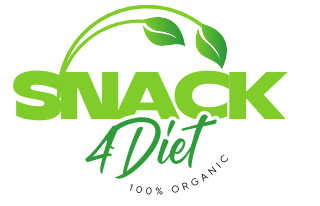Healthy High-Volume Low-Calorie Recipe Ideas That Are Easy To Make
Table of Contents

Exploring tasty low-calorie recipes can change your eating habits. With over 25 quick meals, you can enjoy healthy dishes that help you lose weight. These meals are full of flavor and keep you feeling full.
Volume eating is a smart way to eat healthy. It lets you eat more without taking in too many calories. Ingredients like cauliflower rice and high-protein foods make your meals satisfying and light.
Our selection includes meals with less than 400 calories per serving. These dishes are both healthy and delicious. You’ll find Mediterranean bowls with 31 grams of protein and air fryer chicken under 275 calories. These recipes help you meet your nutritional needs.
Key Takeaways
- 25+ low-calorie meal options available
- Each recipe contains under 400 calories per serving
- High-protein ingredients support satiety
- Meals prepared in 30 minutes or less
- Nutrient-dense ingredients prioritized
- Supports weight management goals
- Flexible recipes for diverse dietary needs
Understanding High-Volume Low-Calorie Eating
Volume eating is a smart way to eat that keeps you full and still watch your calories. It uses low-fat cooking to let you eat more of healthy foods without too many calories.

High-volume foods are full of nutrients and help you eat healthy. They have two main traits:
- High water content (over 90%)
- High fiber content
What Makes Food High-Volume
Foods for volume eating are low in calories but packed with nutrients. Here are some great examples:
| Food | Calories | Water Content | Fiber |
|---|---|---|---|
| Cauliflower | 27 calories/cup | 90% | 2g |
| Spinach | 14 calories/2 cups | 90% | 1g |
| Watermelon | 46.5 calories/cup | 92% | 0.6g |
Benefits of Volume Eating for Weight Management
Volume eating is great for keeping your weight in check. A 2018 study found that eating foods with fewer calories but more volume can help you:
- Feel full without eating too many calories
- Lower levels of hunger hormones
- Keep your energy levels steady
Role of Nutrient Density in Volume Eating
Not all low-calorie foods are the same. Nutrient density is key in volume eating. The CDC says that eating foods rich in nutrients can lower your risk of type 2 diabetes, some cancers, and heart disease.
While volume eating is effective, it’s important to do it wisely. If you’ve had eating disorders, talk to a doctor before trying it.
Essential Ingredients for Volume-Based Meals

Starting with high-volume, low-calorie ingredients is key to making light and tasty recipes. It’s not about cutting out food, but choosing wisely. This way, you get full without taking in too many calories.
To make slimming meals, pick foods that are full of volume but low in calories. Look for foods that are packed with nutrients. They help you feel full and happy.
Top Ingredients for Volume Eating
- Leafy Greens: Spinach, kale, and arugula are full of nutrition but low in calories
- Cruciferous Vegetables: Broccoli, cauliflower, and Brussels sprouts
- Lean Proteins: Chicken breast, fish, tofu, and egg whites
- Hydrating Fruits: Watermelon, strawberries, and cucumber
Mixing these ingredients helps you make meals that are both filling and low in calories. For example, two cups of spinach have just a few calories. They also give you important nutrients and make a big meal.
Smart Volume Eating Strategies
- Choose water-rich vegetables
- Include lean proteins in every meal
- Use herbs and spices for flavor without calories
- Prioritize whole, unprocessed foods
By using high-volume, low-calorie ingredients, you can eat in a way that’s good for your health and helps with weight management.
Low-Calorie Recipe Building Blocks
Starting with the basics is key to making healthy, filling meals. By using simple ingredients, you can make delicious dinners that are good for you. This way, you can reach your wellness goals.

Best Protein Sources
Protein is important for feeling full. Here are some great protein choices:
- Lean chicken breast
- Fish (salmon, tuna)
- Egg whites
- Greek yogurt
- Tofu and tempeh
Fiber-Rich Components
Fiber makes your meals more nutritious and filling. Here are some high-fiber foods:
- Quinoa
- Beans and legumes
- Chia seeds
- Oatmeal
- Whole grain options
Hydrating Vegetables
Vegetables are low in calories but high in volume. Here are some good ones:
| Vegetable | Calories per Cup | Water Content |
|---|---|---|
| Cucumber | 16 | 95% |
| Zucchini | 20 | 94% |
| Lettuce | 5 | 96% |
| Spinach | 7 | 91% |
By mixing these ingredients, you can make high-volume dinner recipes that are both healthy and satisfying.
Quick and Easy High-Volume Lunch Ideas

Looking for volume diet recipes doesn’t mean you have to give up taste. Your lunch can be tasty and healthy, all while keeping calories low. High carb low calorie food helps you feel full without too many calories.
Here are some tasty lunch ideas that are full of volume but low in calories:
- Zucchini Noodle Chicken Meatball Bowl
- Spiralized zucchini noodles
- Lean chicken meatballs
- Fresh herb garnish
- Greek Yogurt Power Salad
- Mixed greens
- Grilled chicken breast
- Berries and chia seeds
- White Bean Turkey Chili
- Lean ground turkey
- Fiber-rich white beans
- Roasted vegetable medley
These low-calorie options will keep you energized all day. Each dish is packed with nutrients but low in calories. They’re great for managing weight and staying healthy.
Pro tip: Prepare ingredients ahead of time to make these lunches fast and easy. Batch cooking saves time and ensures you have a healthy meal ready.
Satisfying Dinner Recipes Under 400 Calories
Making tasty meals that are good for you doesn’t mean you have to give up flavor. These dinner ideas with 400 calories or less will change how you cook. They keep your diet on track without feeling like you’re missing out.
When looking for dinners under 600 calories, it’s important to have variety. This keeps your meal planning exciting. Our recipes make sure you never feel like you’re missing out, even when counting calories.
One-Pot Meal Magic
One-pot meals are easy to make and full of flavor. They require little effort but pack a big punch in terms of nutrition. Here are some great options:
- Garden Chicken Cacciatore (207 calories, 23g protein)
- Spaghetti Squash with Meat Sauce (292 calories, 22g protein)
- Chicken Rice Bowl (239 calories, 19g protein)
Sheet Pan Dinner Delights
Sheet pan dinners make cooking easy and clean up a breeze. They’re also packed with protein. Here are some tasty choices:
- Baked Salsa Chicken (226 calories, 34g protein)
- Grilled Teriyaki Chicken (203 calories, 35g protein)
- Lemon Thyme Chicken (308 calories, 36g protein)
Stir-Fry Sensation
Stir-fries are quick, tasty, and full of veggies and lean proteins. They’re a great choice for a fast, healthy meal. Check out these options:
- Spinach Shrimp Fettuccine (283 calories, 17g protein)
- Shrimp Tostadas with Avocado Salsa (297 calories, 22g protein)
- Indonesian Peanut Chicken (353 calories, 31g protein)
Each recipe is made to keep you full and support your health goals. Pro tip: Try new herbs and spices to make these low-calorie meals even better without adding extra calories.
Smart Cooking Techniques for Low-Calorie Meals
Learning smart cooking techniques can make your low-calorie recipes fun. Healthy eating doesn’t mean you have to give up taste or enjoyment. With the right cooking methods, you can make meals that are good for you and taste great.
Discover these top cooking techniques to improve your low-calorie dishes:
- Air Frying: Cut calorie intake by up to 75% compared to deep-frying
- Steaming: Keeps meals light and full of flavor while keeping nutrients
- Grilling: Adds taste without extra calories
- Roasting: Creates rich flavors with little oil
Herbs and spices are key to making low-calorie recipes tasty. They add no calories but a lot of flavor. Here are some tips to boost your dish’s taste:
- Use fresh herbs like basil, cilantro, and parsley
- Try different spice blends for depth
- Use citrus zests for bright, intense flavors
- Try vinegar-based marinades
Cooking spray is a big help in healthy eating. It has just 2 calories per spray, cutting oil use by up to 10 times. Using non-stick pans and brushes also helps reduce fat without losing flavor.
Creating tasty weight loss meals is about using smart techniques, not cutting out food. By mastering these methods, you can turn simple ingredients into exciting, healthy dishes that help you reach your health goals.
Meal Prep Strategies for Volume Eating
Mastering meal prep is key for low-fat cooking and diet-friendly dishes. Your strategy can make or break your calorie-conscious meals. Good meal prep helps you meet your nutrition goals, saves time, and reduces stress.
Smart Storage Solutions
Proper storage keeps your meals fresh. Here are some tips:
- Use clear, compartmentalized containers for easy meal tracking
- Invest in airtight glass containers to preserve freshness
- Label containers with preparation dates and calorie content
- Separate wet and dry ingredients to prevent sogginess
Precise Portioning Guidelines
Portion control is crucial in volume eating. Here’s a helpful breakdown:
| Meal Component | Recommended Portion | Calorie Range |
|---|---|---|
| Lean Protein | 3-4 oz | 100-150 calories |
| Non-Starchy Vegetables | 1-2 cups | 25-50 calories |
| Complex Carbohydrates | 1/2 cup | 80-120 calories |
Make-Ahead Meal Components
Streamline your diet-friendly dishes with these make-ahead strategies:
- Batch cook proteins like chicken or tofu
- Prepare roasted vegetables in advance
- Cook grains and legumes in large quantities
- Create flavor-packed sauces and dressings
Pro tip: Dedicate 2-3 hours on weekends to meal prep and set yourself up for a week of successful, calorie-conscious meals.
Seasonal Ingredients for Volume-Based Cooking
Discovering light and tasty recipes is easy with seasonal produce. Seasonal ingredients are key for nutritious meals that help with slimming. Fresh, local fruits and veggies taste great and are full of nutrients without many calories.
Starting a seasonal cooking journey changes how you make volume-based meals. Here are the main benefits of using seasonal ingredients:
- Peak Nutritional Value: Fruits and veggies at their best have the most nutrients
- Lower Cost: Seasonal produce is often cheaper
- Enhanced Flavor: Fresh, in-season ingredients taste more vibrant
- Supports Local Agriculture
Choosing the right seasonal ingredients can cut calories while keeping meals satisfying. Let’s look at some nutritious seasonal options:
| Season | Low-Calorie Ingredients | Calorie Range |
|---|---|---|
| Spring | Asparagus, Strawberries | 25-50 calories per serving |
| Summer | Watermelon, Zucchini | 30-60 calories per serving |
| Fall | Butternut Squash, Apples | 50-100 calories per serving |
| Winter | Kale, Grapefruit | 40-80 calories per serving |
By using different seasonal ingredients, you can make varied, low-calorie meals. This keeps your diet interesting and effective.
Creating Flavorful Low-Calorie Sauces and Seasonings
Transforming waistline-friendly dishes doesn’t mean sacrificing flavor. You can make your low-calorie recipes more exciting with tasty sauces and seasonings. These add a lot of flavor without extra calories.
Learn how to make your healthy meals even better with these sauce tips:
- Use fresh herbs like basil, cilantro, and mint to add depth without calories
- Experiment with citrus juices for bright, zesty flavor profiles
- Incorporate vinegars to create tangy, low-calorie dressings
- Blend spices to create complex taste sensations
Homemade sauces are a game-changer. A single tablespoon of a well-made dressing has just 2 calories. This makes it a great choice for your meals. Research shows that tasty sauces can make meals 30% more satisfying while cutting down calories.
| Sauce Variety | Calories per Serving | Unique Characteristics |
|---|---|---|
| Lemon Vinaigrette | 2 kcal | Zesty, bright flavor |
| Cilantro Lime | 2 kcal | Fresh, herbaceous profile |
| Balsamic Reduction | 5 kcal | Rich, concentrated taste |
Pro tip: Make versatile sauce bases that you can change up with different herbs and spices. A basic vinegar-based dressing can be turned into many flavors with just a little effort. Try Asian-inspired sesame or Mediterranean herb blends to keep your meals interesting and healthy.
The secret to great low-calorie sauces is being creative and knowing how to mix flavors without adding too many calories. Your taste buds will love it!
Conclusion
Creating successful weight loss meals is more than just finding diet-friendly dishes. It’s about a holistic approach to nutrition that fits your lifestyle. Your journey with calorie-conscious meals needs patience, planning, and understanding your body’s needs.
Portion control is key in managing your weight. Use smaller plates, track ingredient quality, and choose high-fiber, protein-rich foods. The Healthi app’s BITES function helps track values and make better food choices.
Sustainable weight loss is about building lasting healthy habits, not quick fixes. Prepare meals ahead, use diverse protein sources like chicken and tofu, and focus on nutrient-dense ingredients. Getting advice from a registered dietitian can help tailor your nutrition plan to your health goals.
Your journey to wellness is unique and ongoing. Celebrate each small win, stay consistent, and remember change takes time. By using practical dietary strategies and keeping a balanced approach, you’ll see lasting changes in your nutrition and health.
FAQ
What is volume eating and how can it help with weight management?
Volume eating means eating lots of foods that are low in calories but full of nutrients. Foods like veggies, fruits, and lean proteins help you feel full. This way, you can eat more without gaining weight, which helps with weight control and hunger.
What are the best low-calorie ingredients for high-volume meals?
Good choices include leafy greens, cruciferous veggies, lean proteins, legumes, and low-calorie fruits. These foods are nutritious, filling, and low in calories. They help you eat more without gaining weight.
How can I make low-calorie meals more flavorful?
Use herbs, spices, citrus, and vinegars to add flavor without extra calories. Try roasting, grilling, or air frying for deeper tastes. Add fresh herbs, chili flakes, garlic, and homemade sauces to spice up your meals.
How many calories should a low-calorie meal contain?
A low-calorie meal is usually 300-500 calories for lunch or dinner. But, your needs depend on your age, gender, weight, and activity level. A dietitian can help figure out what’s right for you.
Can I practice volume eating if I’m vegetarian or vegan?
Yes! Vegetarian and vegan diets are great for volume eating. Choose protein-rich foods like legumes, tofu, and tempeh. Add whole grains, nuts, and seeds for balanced nutrition.
What are some quick high-volume meal prep ideas?
Try Mason jar salads, veggie-packed frittatas, and cauliflower rice stir-fries. Also, zucchini noodle dishes and sheet pan meals are quick and healthy. Prepare ingredients like chopped veggies and cooked proteins in advance.
How do seasonal ingredients impact volume eating?
Seasonal ingredients are fresh, nutritious, and often cheaper. They add variety and flavor to your meals. Using seasonal produce ensures you get a wide range of nutrients and supports local farmers.
Are there any cooking techniques that help reduce calories?
Yes! Steaming, grilling, roasting, air frying, and poaching use less fat. These methods keep your meals tasty and low in calories, without losing nutrients.
Can volume eating help with long-term weight management?
Volume eating is a lasting way to manage weight. It focuses on foods that are filling and nutritious. By choosing these foods, you develop healthy eating habits that support long-term weight loss.

